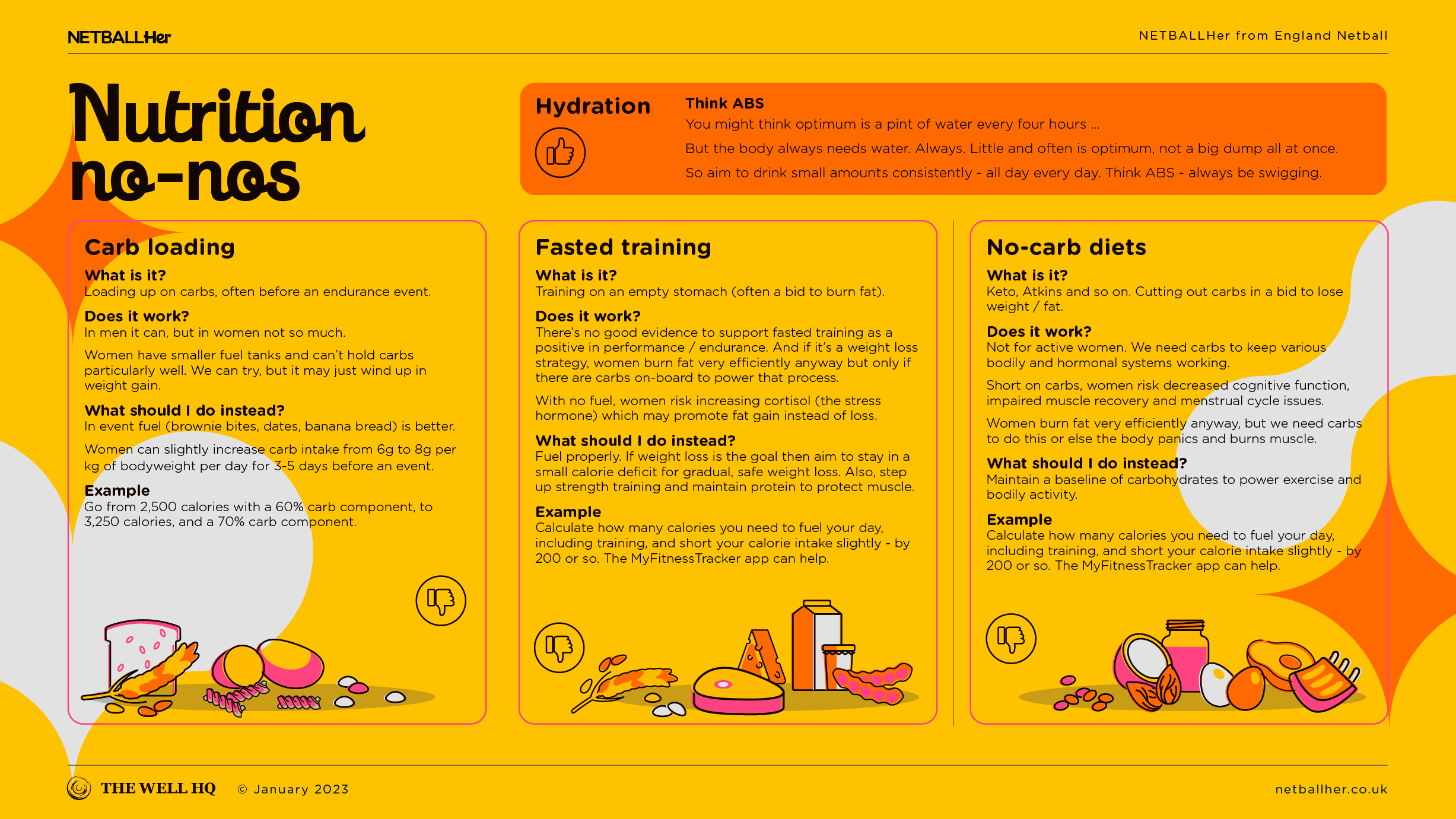Click play for an audio readthrough of this article
If you’re into your training you’ll read a lot about ‘macros’ … but what about micros?
Macros. They’re a big deal in sport. When fit people talk about their macros, they often mean their balance of protein, fats and carbs. Macros command a lot of column inches for their role in helping active people fuel, build, train, recover and optimise.
There’s probably less emphasis out there on micronutrients but don’t let the diminutive name fool you – they’re massively important too.
What are micronutrients?
Micronutrients is a sciencey word for vitamins and minerals. As the name suggests, they’re small and you need only small amounts of them.
With the exception of vitamin D – which we get from food as well as when sunshine hits the skin – the human body does not produce micronutrients itself. Hence we need to consume them.
It’s not uncommon for active women to short their micronutrient intake, or to get their balance of vitamins and minerals wrong. Read on. Both can lead to unpleasantness in terms of health and wellbeing, and in terms of training and performance.
Pumping iron
You probably know this, but your blood contains iron hence blood loss during menstruation can lead to an iron deficiency. What you mightn’t know is that iron can also be lost through urine, sweat, and as a consequence of high impact exercise.
Intense exercise causes red blood cells – where most of your iron lives – to rupture and die. This sounds alarming but don’t panic, your bone marrow will make more red blood cells if your diet is where it needs to be.
Anyway, iron. As a woman your iron needs are higher because of your periods, and as an active woman your iron needs are higher still. This higher demand means women who love to train often don’t get enough. It’s been estimated that a whopping 60% of active women may have an iron deficiency.
There are two sources of iron in your food: haem and non-haem (haem as in related to blood). Haem iron is only found in animal foods, like beef, fish and poultry and it’s the kind of iron the body absorbs most easily.
The other type of iron, non-haem, is found in lots of plant-based foods. Think soya, dried fruit, legumes, fortified cereals, green leafy veg and wholegrains. There are plenty of veggie-iron-options if you’re not a meat eater. Non-haem iron isn’t as easy for the body to absorb, but if you consume foods rich in vitamin C alongside your plant-based iron then your body will take the iron on-board more efficiently.
We said earlier that up to three in five (60%) active women have an iron deficiency, so if you suspect you’re one of them please get it confirmed – don’t just guess – via a blood test from your doctor. Please also be aware that an iron deficiency can take up to six months to correct.
Lastly and sure, this is a world where iron supplements exist but we would always advise women to think diet first. Iron supplements can cause constipation and even upset your cardiovascular system. So yeah, diet first …
Vits C&D for bones and more
Vitamin C is the boss of bone health. It builds and repairs them. As active women it’s not just our muscles that get battered – it’s our bones too.
Vitamin C is a dab-hand at building strong and healthy bones, as well as aiding blood clotting, fluid regulation and keeping your nerves and signals on high alert.
As you may know, citrus fruits are excellent sources of vitamin C, but decent amounts can also be found in cruciferous vegetables (that’s broccoli, sprouts, cabbage and cauliflower), strawberries, bell peppers and even white potatoes.
Next, no conversation about bone health is complete without mentioning calcium and vitamin D. On its own, calcium is major in maintaining bone health but it cannot be absorbed by your bones without vitamin D. Hence women who are low on vitamin D (and many of us are, especially in winter) then you may well be calcium deficient, too.
Calcium is generously found in dairy, bony fish (like sardines) and, once again, those wonderful leafy greens.
Back to vitamin D, though, and it’s so much more than a calcium accelerator. It’s actually a steroid hormone and essential in maintaining female hormonal health. There’s a glut of research which shows a diet rich in calcium and vit D is a superb natural way to combat premenstrual syndrome and pain.
The rub is that only a handful of foods – fatty fish, fish liver oils, beef liver, egg yolks and cheese – yield good amounts of vitamin D, hence why it’s so important to get out in the sunshine.
Exposing your skin to the sun (lotion mind, stay safe) offers the body 70-80% of the vitamin D it needs. That’s less-than-good news if your winters are long and cold and dark. So it’s always a good idea to test your vitamin D and calcium levels each winter. Oh and once again, don’t guess – get a blood test.
If you are found to be deficient then try to increase via your diet. If diet alone doesn’t raise levels then it’s time to consider supplements, and note the following:
- Calcium citrate is more expensive but it absorbs easier and you don’t have to take it with food
- Calcium carbonate is cheaper but absorbs less well, and must be taken with food for optimal results
- Vitamin D absorbs poorly if it’s not taken with food and for best results, take with fatty foods
Magnesium the magnificent
This micronutrient is a serious wizard. Magnesium is important for your bones, your cardiovascular system and your blood pressure. It also calms the nervous system and regulates the millions of signals sent by your nerves – including, importantly, from brain to ovaries. Magnesium, basically, plays a vital role in dozens of systems that ensure your body functions as it should.
Unconvinced? Getting enough magnesium helps everything from muscle cramps to insomnia. Magnesium has also been shown to regulate women’s oestrogen levels and insulin production, thus ensuring stable blood sugar levels and thyroid activity.
Naturopathic doctor Lara Briden describes magnesium as the first-line in ensuring a healthy menstrual cycle, especially for women who suffer with polycystic ovary syndrome, PMS or period pain.
Impressive, right? If you’re now thinking ‘I want more magnesium’, you’ll find it in wholegrains, legumes, nuts, seafood and, you guessed it, leafy greens. Make sure you have plenty of magnesium mainstays in your diet and you won’t go far wrong …
Provided you manage your stress levels reasonably well, that is. Your body excretes more magnesium when you’re stressed so please bear that in mind. And note that magnesium is mostly stored in the body’s cells so it can’t easily be measured via blood or urine tests.
Instead, red flags to watch for include:
- Muscle weakness
- Pins and needles
- Cramping
- Irritability
Think zinc
Like magnesium, zinc is a multitalented micronutrient. It boosts immune system function. It ensures various hormones get to where they need to go in the body. It’s a friend in supporting healthy ovulation and period pain. And it turns our food into energy.
For active women, zinc is particularly important for its role in muscle growth and repair. In fact, the active body uses zinc for muscle recovery in such quantities that athletes are very often found to be zinc deficient.
Rule of thumb: the more you train, the more zinc you’ll need. And because the body can’t store zinc, you’ll need a constant supply of it through foods such as beef, fish, eggs, wholegrains, legumes and dairy.
Oh and if you aren’t yet fully convinced of the magic of zinc then try this on for size:
Every November, UK Sport doctors send Olympic and Paralympic athletes ‘winter survival kits’ in a bid to reduce the number of training days lost to illness over the cold, dark months.
Elite athletes are four times more likely to get ill during and after Christmas; a combination of less training, seasonal excesses, and more contact with more people … hence more germs.
It’s worth a giggle that this ‘winter survival kit’ includes a written kibosh on kissing under the mistletoe and instructions for ‘proper’ handwashing. But as well as the funnies, each survival kit includes a nice big pack of zinc lozenges.
Because recent studies show that elemental zinc, taken daily in 75mg lozenges, shortened the duration of upper respiratory tract infections – that’s cough, colds and sore throats to you and me – by three days, if taken less than 24-hours after symptoms start.
Science believes in zinc, and you should too. In fact, that goes for all micronutrients. They might be small but they pack a punch, especially in absentia.
Micro your diet
With extra thought and planning, you should be able to get the micros you need from your diet without resorting to supplements. The main exception is vitamin D during winter when the sun hibernates and we all patiently wait for a chance to snog a germy stranger under the mistle … wait, not allowed? Dangit.
As a reminder, the content of the course belongs to The Well HQ. You have permission to access and use the content yourself or, if you are an organisation, for the number of users selected, but are not otherwise permitted to share such content with others, all in accordance with our Course Terms and Conditions.

